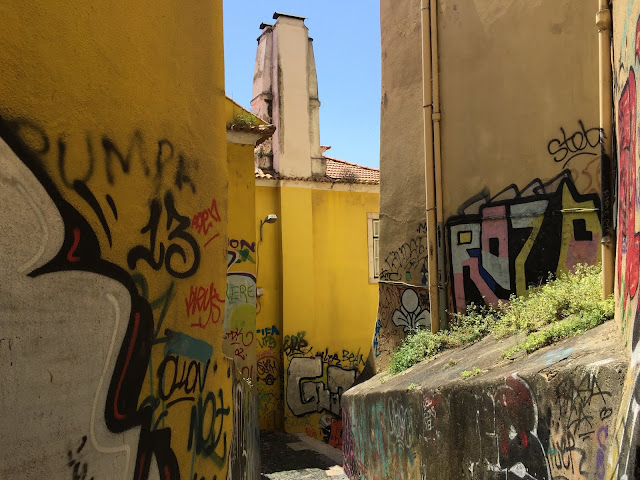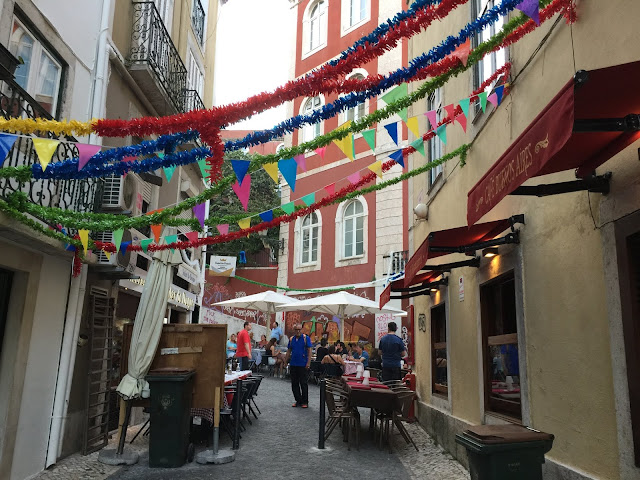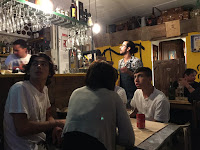Tuesday, June 26, Road Trip along the Algarve Coast
We walk back to our hotel to recharge our phones and collect our clean laundry and take a taxi to Euro Rental Car. Art is miserable and anxious over my arrangement to rent a car for our drive south to the coast and he makes no “bones” about it. Our intention is to spend the night in Salema and there is no direct public transportation. I reserved a car in advance and when I ask for a map, the woman behind the desk informs me that they have run out of maps. Unbelievable!. The man behind the counter assures us that the GPS will get us there easily and sets the GPS to English with our end destination, Salema. He also prints out Google map directions and we are on our way via countless roundabouts before we access the highway and Art begins to relax. The drive is to take us 3.5 hours and we expect to arrive at the coast around 8:00 P.M. The golden rolling hills are dotted with cork oaks and the countryside looks much like the stretch of California between King City and Santa Barbara. We see a few storks nesting in roosting platforms, telephone pole high along the highway. Our credit card is connected to a prepaid device attached to our windshield that records the various tolls when we pass through. Every so often, we pass under an arch with multiple recording devices hanging down and our car beeps as another Euro or two are added to our bill. The GPS is excellent and eventually Art concedes that the drive is not so terrible after all. We stop at designated rest stop to use the facilities and pick up snacks. It is not unlike any U.S.A. freeway rest stop. The countryside becomes steeper and is visually dramatic in the late afternoon light.
 |
| Salema Portugal |
 |
| Salema Town |
 |
| A peek of the beach |
Navigating is a bit more complicated when we near the coast and Art is tiring from the drive and I wish that I could take over but he is to be the only driver on our contract. We head east toward Sagres, the furthest point of Europe and begin looking for the turn off to Salema. Although we make a few wrong turns, we are soon winding down toward the coast and arrive in Salema, a small sea side tourist town and fishing village. Art finds street parking and we walk a block to the village center and at the first hotel, inquire about a room. We are relived that there is availability and take the 3rd floor, 80 Euro room. Although the hotel boasts 3 stars, the room has seen brighter days but we do have an ocean view and aside from sleeping we will spend little time here. We stow our luggage and head downstairs to explore the town and choose a restaurant for dinner. A soccer game is playing in the hotel bar so our foray outside is slightly delayed but we are soon walking along the peaceful waterfront where we have half a dozen restaurants to choose from. We choose one owned by a German couple where we sit and sip glasses of wine and wait for our meals. Art orders seafood pasta and I choose a goat cheese salad. Our meals are reasonably good. After dinner we stroll along the one cobble stone street of the town and return to our hotel for the night.
Wednesday, June 27th. Sagre, The Furthest Point of Europe and onto Tavira.
The included breakfast at our hotel is uninspiring. It is a beautiful sunny morning and we walk down to the harbor and turn right along the white sandy beach. The water is crystal clear but Atlantic Ocean cold as we walk along the edge of the gently lapping sea. The ocean is so still that we are tempted to go kayaking but other things are on our day’s agenda and we content ourselves with a peaceful beach walk along this pristine and dramatic beach. Yellow and orange sandstone cliffs rise dramatically above the beach. It is low tide and the slabs of rock that were underwater at high tide are carpeted with a lush green sea moss. The montage of colors; azure blue ocean, white sand, mossy green rocks and yellow and orange cliff faces make this beach one of the most dramatically beautiful ones I have had the privilege of making footprints on.
 |
| Salema Beach |
 |
| Salema Beach |
 |
| Art, Salema Beach |
 |
| Red cliffs and mossy rocks along Salema Beach |
We walk to the end of the sandy crescent and retrace our path towards the slowly waking village. Although Salema used to be an active fishing village, there are now only half a dozen old salts still making their living fishing and trapping octopus. We walk towards the other end of the beach and watch a small tractor launch a fishing boat out to sea. Another fishing boat on the sand collects it’s nets with a mechanical clipping churn and I ask if I may take a photo? The weathered fisherman nods and I take a video of them rolling in their nets. Further up the beach rests another fishing boat but when I ask to take a photo the fisherman scowls and shakes his head.
 |
| Octopus traps |
 |
| Fishermen and their nets |
 |
| Salema Town |
We return to our hotel via the cobble stone shop lined street, check out and drive the 10 kilometers to Sagres, the most southwestern point of Europe. Parking at light house is jammed and souvenir and food wagons line the blustery path to the lighthouse. Nevertheless, the cliff side views are breathtakingly beautiful and we take full advantage of the photo ops before starting our drive back towards Tavira.
 |
| View from the Sagres lighthouse |
 |
| Cliffs of Sagres |
 |
| Studio Bongard at the Sagres lighthouse |
 |
| Bongard fish sculpture |
Art now has the hang of roundabouts and we are soon on the toll highway and the two hour drive to Tavira is easy. Although most of the drive is inland, we stop in Lagos for a marvelous fish lunch.
 |
| The Algarve coastline |
 |
| Lagos harbor |
 |
| Fish restaurant in Lagos |
We arrive in picturesque Tavira about 2:00 P.M, find street side parking and set off to the tourist office to find a room for the night. The day is insufferably hot and the woman at the IT tourist office is far from charming. She suggests a 4 star hotel and our inquiry about a few simpler hotels suggested in the Rick Steves guide book seems to displease her. She scrawls a few suggestions on a city map and we are off to investigate our options. All are close by but the first guest house is fully booked as well as one of the Rick Steves recommendation. We walk 10 minutes along the riverfront and come to the Marina Hotel which has a double river view room available for 80 Euros a night including breakfast. The room is lovely with a vintage tile bathroom and a balcony overlooking the river.
 |
| Tavira, a city built on two sides of the river |
 |
| Our river front hotel |
 |
| The view from our hotel balcony |
 |
| Tile rooftops of Avira |
We return to our car and Art navigates the narrow streets to our hotel where we will have free parking until 9:00 A.M. tomorrow morning. Quick showers and our air conditioned room soon revive us and we head out to enjoy the evening. We sit for drinks at an outdoor café and as Art watches a few minutes of a soccer game, I find contentment in people watching and enjoying a glass of crisp Portuguese wine. It is still daylight when we cross the pedestrian bridge to search for a restaurant for dinner.
 |
| Pedestrian bridge in Tavira |
 |
| Afternoon light in the old city |
 |
| Restaurants and cafes |
The outdoor tables at Aquasul Restaurant are full or reserved but we are fortunate that they have a single available table for 2 inside and we slip into our seats gratefully. The tuna Carpaccio with arugula is exceptional as is the chicken curry. We order individual glasses of wine and Art, anxious to sample more of the excellent food orders mushroom ravioli, a mistake of overindulgence. Dinner with 2 glasses of wine each is about 50 Euros or $60 including tax and tip. It is close to midnight by the time we climb the stairs to our hotel room.
Thursday, June 28th – The Saga of the Rental Car Return – Tavira
Because I am not authorized to drive the rental car, Art must return it today in Faro. Although Faro is only about 30 miles away, we both know that it will take the better part of the morning for him to return it at the Faro airport and catch a bus back to Tavira. Art graciously agrees to do this alone while I stay in town and catch up on writing and some Marty Magic business. Art drives off around 9:30 A.M. and I sit at a simple café near our hotel and write for a couple of hours, sipping on sparkling water to stay hydrated.
 |
| A blissful morning writing at a riverfront cafe. |
It’s another sweltering day and I want to find something cooler to wear. For a seasoned traveler, I have not packed appropriately. The jeans that the hotel laundered in Evora are now too tight to wear comfortably and I want to blame it on the hot water and dryer and not on the extra calories that I have been consuming. This heat calls for a cool dress and set out along the strip of shops adjacent to our hotel and buy a knee length blue cotton dress and a light straw hat. Art texts me to inform me that the rental car return process sucks but that he thinks he is on the right bus back and will arrive in Tavira at 2:25 P.M. I text a reply that I will meet him at the bus station, a short walk from our river front hotel.
 |
| Secluded cafe along the river |
 |
| Boat docking in Avira |
Understandably, he is not in the best of moods when he returns but after recharging at our hotel, we set out to enjoy the late afternoon in Tavira. We stop briefly in the cool of an Irish pub to watch a few minutes of the World Cup and then wanter onto an upscale riverfront café for cool drinks and tidbits of calamari. Everything is very affordable, making cafe and bar hopping fun and financially painless. A house wine costs about 2 Euros ($2.50) and the premium wines about twice that amount. Tax and tip are included in the prices so by California standards, café hopping is extremely affordable and delightful in this picturesque town of whitewashed buildings and narrow cobblestone streets. As the afternoon turns to evening, street musicians and performers stake their territory on the bridge and in the plazas.
 |
| A balmy Tavira evening |
We choose an inviting rooftop restaurant for dinner but the meal is disappointing although the semi sweet white wine with the chameleon on the label is excellent. It is after 10:00 P.M. as we walk back towards our hotel and we hear dance music. There is music in the Zocalo near our hotel. Art fast walks his pack and my purse back to our room and returns shortly, hand outstretched and pulls me onto the square where we join the other dancers. Although Polka is not our dance, we find quite a few songs that we can dance to in the welcome cool of the evening. We are beginning to understand the afternoon ‘siesta.’ Business are open between 10:00 A.M. – 1:30 -2:00 P.M. They then close for several hours, opening again at 4:00 P.M. or 5:00 P.M. and remaining open until 9:00 P.M. or 10:00 P.M. Restaurants, bars and cafes are open until midnight. Young children play and dance with their parents late into the evening. It is simply too hot in the mid-day to do much more than ‘siesta.’























































































































































































